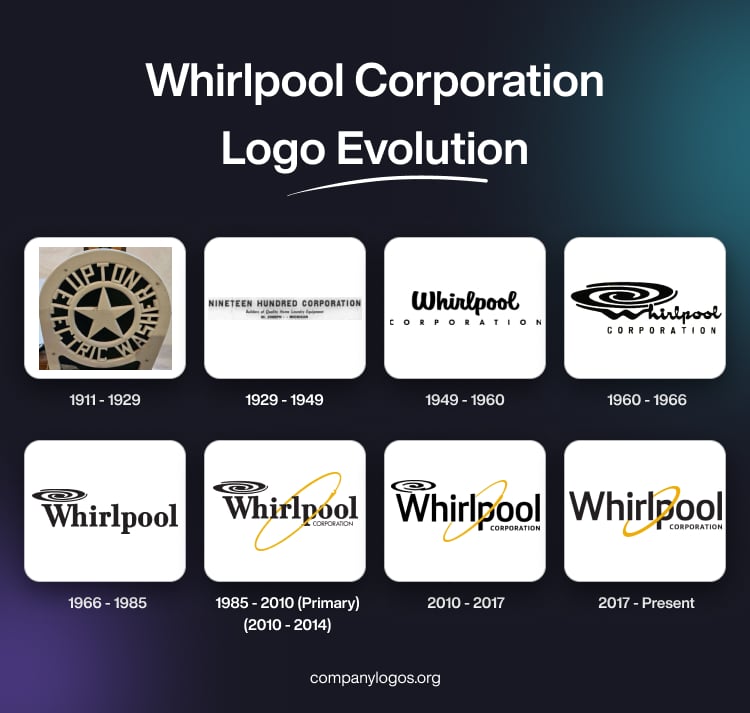
Whirlpool Corporation is one of the leading home appliance manufacturers in the world and is known for shaping how people live and work in their homes. It was founded in 1911 in Benton Harbour, Michigan, and has since grown from producing a single electric washing machine to offering a wide portfolio of innovative products. These included refrigerators, washing machines, ovens, dishwashers, and more. The article explores the various logo changes undertaken by Whirlpool Corporation over the years, among other details of the company.
The Genesis of the Whirlpool Corporation Logo (1911 – 1929)
Long before Whirlpool Corporation came into being; it started as the Upton Machine Company that produced electric wringer washers. So, the first logo featured a solid five-pointed star in metal colour enclosed within a circle. It was further enclosed within a bigger circle with a thick outline. The wordmark “UPTON ELECTRIC WASHER” appeared in a circular alignment between the circles.
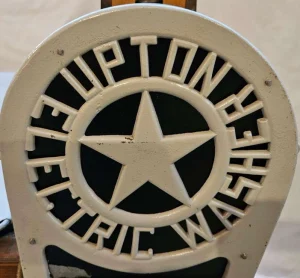
(1929 – 1949)
The Upton Machine Company had become the Nineteen Hundred Corporation in 1929. The company logo of that time featured the new company name in a bold black uppercase sans-serif typeface. The brand name was followed below by the tagline “Builders of Quality Home Laundry Equipment” in italics.

(1949 – 1960)
In 1949, the company name was changed to Whirlpool Corporation, and the logo saw the name displayed in a handwritten cursive script in black. It was followed by the wordmark “CORPORATION” in a smaller size in uppercase with adequate spacing between the letters.

(1960 – 1966)
The 1960 logo saw a huge black swirl appear above the stretched letter “W.” Furthermore, the glyphs forming the wordmark appeared as ripples on the surface of water. The wordmark “CORPORATION” in black uppercase appeared below as a tagline.
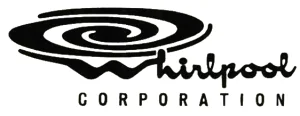
(1966 – 1985)
Since the brand name in the earlier logo was not legible, it was changed in 1966. Although the iteration was similar in style to the earlier one, the wordmark was executed using a classic serif typeface in black. The whirl above was much smaller and did not dominate the whole wordmark.

(1985 – 2010) (Primary), (2010 – 2014)
The logo design of this era saw the addition of a large golden oval diagonally across the brand name with classic serifs. The oval represented a “whirl” or “orbit”, while the wordmark “CORPORATION” appeared as a tagline below to the right.
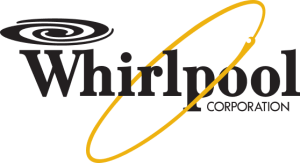
(2010 – 2017)
The wordmark in a title case here saw the removal of the serifs. Besides, the whirl above became thinner and smaller. The size of the golden oval became smaller as well. The tagline “CORPORATION” in uppercase is featured below, but to the right.

(2017 – Present)
The current logo does not feature the whirl symbol above, while the golden oval across the wordmark has become thicker. Further, the upper ends of the letters “h” and “l” display diagonal cuts.
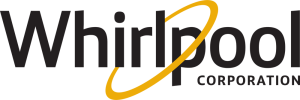
The Elements of the Whirlpool Corporation Logo
Font
The wordmarks used in the Whirlpool Corporation logo use a modern, bold, and clean sans-serif typeface, which is similar to FS Silas Sans Bold. The bold and simple letters of the typeface convey clarity, accessibility, and forward thinking.
Colour
The colour palette used to depict the logo of Whirlpool Corporation includes black for the wordmark and universal yellow for the ring. Here, the yellow colour for the ring symbolises integrity, commitment to quality, and customer service. The black colour, on the other hand, symbolises reliability and strength.
The History of Whirlpool Corporation
Whirlpool Corporation began its journey in 1911 in Benton Harbour, Michigan, when Lou Upton, his uncle Emory Upton, and Lowell Bassford founded the Upton Machine Company. Their first innovation was an electric-powered wringer washer, which was a revolutionary advancement at a time when most laundry was done by hand. The company soon partnered with Federal Electric, a subsidiary of Commonwealth Edison, and sold these machines under the “Nineteen Hundred” brand name. This partnership saw early success for the company and established its reputation as a pioneer in electric home appliances.
During the Second World War, the company redirected its manufacturing efforts toward producing aircraft components and military equipment for the U.S. armed forces. After the war, as consumer demand for home appliances grew, Upton Machine introduced its first automatic, spinner-type washer under the Whirlpool name in 1948. The overwhelming success of this product prompted the company to adopt Whirlpool as its official corporate name in 1949. This way, it signalled a new era of innovation and brand identity.
In the 1950s, the firm formally became Whirlpool Corporation and began to expand its product line and partnerships. In 1951, Whirlpool entered a joint venture with Sears, Roebuck & Co. to produce appliances under the Kenmore brand. The company grew rapidly through acquisitions, which included Seeger Refrigerator Company and Nineteen Hundred Corporation in 1955.
These acquisitions broadened the range of products to include refrigerators and other major home appliances. By 1957, Whirlpool became the first appliance manufacturer to offer a complete line of coordinated home appliances. It was established as a leader in the American home appliance industry.
Throughout the seventies, eighties, and nineties, Whirlpool was transformed into a global brand. It did so by expanding operations into Europe, Latin America, and Asia. Some of the key milestones during this era included the 1986 acquisition of KitchenAid from Hobart Corporation, which gave Whirlpool a foothold in the premium appliance market. Between 1989 and 1991, Whirlpool entered the European market by acquiring a majority stake in Philips’ appliance division.
In 1996, Whirlpool strengthened its Latin American presence by acquiring Brazil’s Multibrás S.A., thereby positioning itself as one of the largest appliance producers in the Americas. These strategic acquisitions turned Whirlpool from an American manufacturer into a multinational industry leader.
Entering the 21st century, Whirlpool Corporation focused heavily on innovation, sustainability, and smart technology. The landmark 2006 acquisition of Maytag Corporation added several renowned brands to its portfolio, such as Maytag, Amana, JennAir, and Magic Chef. During the 2010s, Whirlpool introduced energy-efficient and connected home appliances by integrating digital technologies and mobile connectivity.
Whirlpool Corporation operates in nearly 170 countries with over 70 manufacturing and technology research centres worldwide. Its brand portfolio includes Whirlpool, Maytag, KitchenAid, Amana, JennAir, Indesit, and Brastemp. These brands make Whirlpool Corporation one of the most influential names in the global home appliance sector. The corporation remains committed to sustainability, smart home solutions, and reducing its environmental footprint.
Interesting Facts About Whirlpool Corporation
- Whirlpool started in 1911 when Lou Upton invested in a failed business that made hand-powered washers. He salvaged a single electric motor from the company’s inventory and used it to invent the first electric wringer washer. This laid the foundation for what would become Whirlpool Corporation.
- The company wasn’t always called Whirlpool. It was originally named the Upton Machine Company. The name “Whirlpool” first appeared in 1948 for an automatic washer model, and it became so popular that the company officially adopted Whirlpool Corporation as its name the following year.
- During the Second World War, Whirlpool temporarily stopped making household appliances and switched to producing military components such as aircraft parts and gear assemblies for the U.S. armed forces. After the war, the company returned to appliance manufacturing to meet the rising demand for home products.
- By 1957, Whirlpool became the first manufacturer to offer a complete line of coordinated home appliances. These included washers, dryers, refrigerators, and ranges.
- Whirlpool operates in nearly 170 countries and has more than 70 manufacturing and technology centres worldwide. Its brands include Whirlpool, Maytag, KitchenAid, Amana, JennAir, Indesit, and Brastemp, among others.
- Through acquisitions, Whirlpool has become the parent company of several household names. For instance, it acquired KitchenAid in 1986, Maytag in 2006, and Indesit in 2014. These greatly expanded its global market presence and product diversity.
- Whirlpool has been at the forefront of smart home innovation. It created connected appliances that integrate with Amazon Alexa, Google Assistant, and mobile apps. These allow users to control washing machines, ovens, and refrigerators remotely for convenience and efficiency.
- Whirlpool has invested heavily in sustainable design and energy efficiency. Many of its appliances are ENERGY STAR® certified, and the company has pledged to reach net-zero emissions by 2030 in its operations. It also recycles over 90% of its manufacturing waste globally.
- Since 1999, Whirlpool has been a proud partner of Habitat for Humanity. In pursuance of this, the company has donated tens of thousands of appliances to help build homes for families in need. This initiative reflects the company’s commitment to improving life at home, not only for customers but also for communities worldwide.
- Whirlpool has filed over 6,000 patents globally. These cover innovations in laundry technology, kitchen design, and energy efficiency. It even operates a state-of-the-art innovation centre in Michigan to develop new materials, sensors, and AI-based solutions for home appliances.
- Despite its global reach, Whirlpool is based in Benton Harbour, Michigan, the same small city where it began over 110 years ago. The company’s commitment to its roots remains a point of pride.
- The golden ring in Whirlpool’s logo, also called the “Ring of Promise”, symbolises the company’s commitment to integrity, quality, and care. It represents the continuous bond Whirlpool maintains with its customers and employees around the world.
- Whirlpool has consistently been listed on the Fortune 500 as one of America’s largest corporations. It is also frequently recognised as one of the World’s Most Admired Companies by Fortune magazine for its innovation and social responsibility.
- In collaboration with NASA, Whirlpool helped design space food systems and compact appliances for astronauts, such as prototypes of refrigerators and food storage for space missions.
- From the first electric washer in 1911 to today’s AI-powered smart appliances, Whirlpool Corporation has continuously evolved with technology and consumer needs.
Finally
The evolution of the Whirlpool Corporation logo reflects the journey of the company from humble origins to a global appliance leader. The logo design started with a warm, cursive-script wordmark in the early years. It reflected a personal, almost handwritten feel that resonated with the household context. Over time, the addition of the whirl symbol above the letter “W”, and later the gold orbit/ring around the wordmark, gave visual expression to the meaning of the brand name (“whirl”, rotation, movement) and underscored the technological progress and energy of the company.